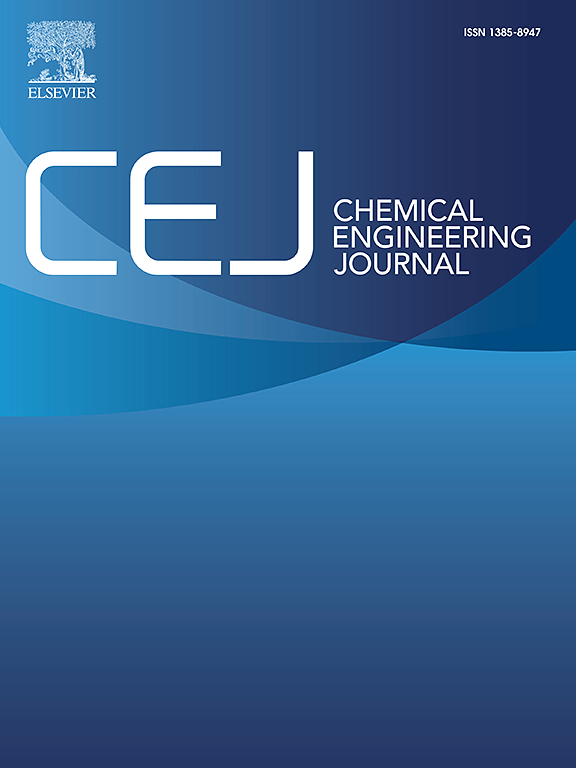具有增强非均相界面的壳聚糖插层直托石/生物质碳气凝胶用于宽带微波吸收
IF 13.2
1区 工程技术
Q1 ENGINEERING, CHEMICAL
引用次数: 0
摘要
由于生物炭材料的非均质界面不足导致的窄带吸收严重阻碍了其在微波吸收领域的进一步应用。本文介绍了将天然硅酸盐粘土累托石(REC)片层与几丁质/壳聚糖(CT/CS)生物质碳相结合精心制作的复合多孔碳气凝胶。用壳聚糖嵌层将薄片组装到再生甲壳素纤维表面。碳化后,片层和几丁质/壳聚糖衍生的生物碳形成具有许多异质界面的定向分层细胞结构。这种创新的设计调节了介电特性,微调了阻抗匹配,显著提高了吸收性能。因此,厚度仅为3.5 mm的复合气凝胶实现了前所未有的8.3 GHz(9.7-18 GHz, X-Ku波段)宽带微波吸收带宽。这一显著的带宽延伸到X波段的58%,包括整个Ku波段,超过了大多数微波吸收材料(MAMs)的能力。雷达横截面模拟证实,碳化REC/CT/CS (cRTS)可以显著减少雷达反射信号(90°时为44 dBsm),突出了其作为最先进雷达隐身材料的潜力。这项开创性的工作为MAMs的发展建立了一个新的范例,展示了可持续生物质和低成本粘土在构建具有超宽带吸收能力的微波吸附剂方面的潜力。本文章由计算机程序翻译,如有差异,请以英文原文为准。

Chitosan-intercalated rectorite/biomass carbon aerogels with enhanced heterogeneous interfaces for broadband microwave absorption
Narrow-band absorption caused by insufficient heterogenic interfaces in biomass-derived carbon materials has significantly impeded their advanced applications in microwave absorption field. Herein, we introduce composite porous carbon aerogels, meticulously crafted by integrating natural silicate clay rectorite (REC) lamellae with chitin/chitosan (CT/CS) biomass carbon. The lamellae are intercalated with chitosan and assembled onto the surface of regenerated chitin fibers. Upon carbonization, the lamellae and chitin/chitosan-derived bio‑carbon form an oriented hierarchical cellular architecture with numerous heterogeneous interfaces. This innovative design modulates the dielectric characteristics, fine-tuning impedance matching and significantly enhancing absorption performance. Consequently, the composite aerogel, with a thickness of only 3.5 mm, achieves an unprecedented broadband microwave absorption bandwidth of 8.3 GHz (9.7–18 GHz, X-Ku band). This remarkable bandwidth extends to 58% of the X band and encompasses the entire Ku band, surpassing the capabilities of most microwave absorbing materials (MAMs) reported. Radar cross-section simulations confirm that carbonized REC/CT/CS (cRTS) can significantly diminish radar reflection signals (44 dBsm at 90°), highlighting its potential as a state-of-the-art radar stealth material. This pioneering work establishes a new paradigm in the development of MAMs, demonstrating the potential of sustainable biomass and low-cost clay in constructing microwave adsorbents with ultra-broadband absorption capabilities.
求助全文
通过发布文献求助,成功后即可免费获取论文全文。
去求助
来源期刊

Chemical Engineering Journal
工程技术-工程:化工
CiteScore
21.70
自引率
9.30%
发文量
6781
审稿时长
2.4 months
期刊介绍:
The Chemical Engineering Journal is an international research journal that invites contributions of original and novel fundamental research. It aims to provide an international platform for presenting original fundamental research, interpretative reviews, and discussions on new developments in chemical engineering. The journal welcomes papers that describe novel theory and its practical application, as well as those that demonstrate the transfer of techniques from other disciplines. It also welcomes reports on carefully conducted experimental work that is soundly interpreted. The main focus of the journal is on original and rigorous research results that have broad significance. The Catalysis section within the Chemical Engineering Journal focuses specifically on Experimental and Theoretical studies in the fields of heterogeneous catalysis, molecular catalysis, and biocatalysis. These studies have industrial impact on various sectors such as chemicals, energy, materials, foods, healthcare, and environmental protection.
 求助内容:
求助内容: 应助结果提醒方式:
应助结果提醒方式:


